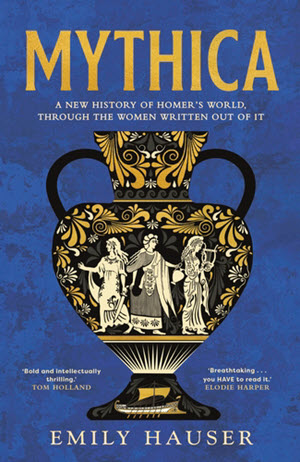Mythica
 It is commonly said of writers these days that you have to have more than one string to your bow. As well as being a novelist you might work on comics, or games, or run creative writing courses, or be a journalist. Whatever pays the bills. These days the same seems to be true of academics. For example, if you are an historian, you might start a podcast, or write historical novels.
It is commonly said of writers these days that you have to have more than one string to your bow. As well as being a novelist you might work on comics, or games, or run creative writing courses, or be a journalist. Whatever pays the bills. These days the same seems to be true of academics. For example, if you are an historian, you might start a podcast, or write historical novels.
Someone who has done the latter very successfully is Emily Hauser. She has Classics degrees from Cambridge and Yale, but she has also written a popular trilogy of novels based on the Trojan War. And of you are a highly competent Classicist who can also write novels, doing a popular history book is an obvious thing to do.
Mythica seems to have begin life as something a little more academic. Hauser’s Wikipedia entry mentions a book called Penelope’s Bones: A New History of Homer’s World through the Women Written Out of It published by Chicago University Press. Someone clearly thought the book deserved a bigger audience. With a new title, but the same subtitle, it has been published by Doubleday and is all over Waterstones of late. And deservedly so.
The approach that Hauser takes is to pick women out of the Iliad and Odyssey, and use each one to explore a facet of Bronze Age history so as to guide her readers through the latest academic research on the presumed time of Achilles and Hector. Being a novelist, Hauser opens each chapter with a short fictional section introducing us to the woman whose (presumed fictional) life she will next cover.
Some of these women are well known, such as Helen, Circe and Penelope. Some are goddesses. Others are less well known. There is a chapter on Briseis, the slave girl over whose ownership Achilles and Agamemnon quarrel. Here we get to see how taking women as slaves was a common feature of Bronze Age warfare, not just for use in bed, but also to power the winning king’s textile industry. Hauser returns to this subject in the chapter on Calypso, pointing out that Odysseus’s long stay on her island was not so much a result of his lust, or her sorcery, but the enormous amount of time it would take one woman so make a sail for a ship on which he could leave.
Much of the research that Hauser highlights was well known to me. The chapter on Penthesilia, Queen of the Amazons, covered very familiar ground. I was also aware that Troy is now considered to be the city known as Wilusa to the Hittites. But the chapter on Hecuba, Priam’s queen, opened my eyes to the importance of queens in Hittite society. I was delighted to discover that Puduhepa, the wife of King Hattusili III, was considered so important that her seal appears alongside his on the treaty signed with Ramesses II after the Battle of Qadesh (famous as being the world’s first written peace treaty between nations).
In other places Hauser points out things in Homer’s texts that we really should have noticed. For example, when Odysseus winds up on the island of the Phaeacians it is not King Alcinous whom he has to beg for help, but Queen Arete. Quite what the Iron Age Athenians who so loved Homer’s work would have made of this is a mystery to me, given how awful they were to their own women. She also notes that Menelaus is King of Sparta only by right of his marriage to Helen, which hints of some sort of matrilineal descent such as we see in the Fourth Branch of the Mabinogion.
Hauser’s knowledge of Bronze Age Greece, and of Cretan civilisation, is superb, and I have to bow to her knowledge of the Hittites as I know no better. When it come to Egypt and Mesopotamia she is perhaps not quite as well read on the latest research as she might be, but her audience is not going to notice.
This does, however, bring me to one small quibble. Hauser is, in general, trans positive. The chapter on Athena points out how gender-fluid that goddess appears in myth (not to mention her being born of Zeus rather than of anyone female). This leads her to discussion of the gender-variant followers of Inana/Ishtar is Mesopotamia, and a character known as Silimabzuta who appears to self-identify as a ‘man-woman’. There are, as far as I know, only two references to this person in the literature. One is in a paper by Julian Reade in a 2002 edition of the German journal, Archäologie Zeitschriften. The other, somewhat more accessible and detailed, is my essay trans people in Mesopotamia on the Notches website. It is great that Silimabzuta is getting noticed but, if you are going to write about them, is it really too much to ask to cite the trans woman historian who brought their story to the world? Apparently it is.
Anyway, matters of academic pride aside, Mythica is a wonderful book that taught me a lot, and I think of myself as someone who has good knowledge of the subject matter. Although it does contain a lot of very good history, it is also very readable and can certainly be enjoyed by anyone with a passing interest in Homer (whoever he, or she, or they, might have been).

Title: Mythica
By: Emily Hauser
Publisher: Doubleday
Purchase links:
Amazon UK
Amazon US
Bookshop.org UK
See here for information about buying books though Salon Futura